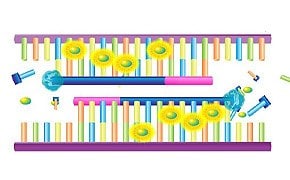qPCR

정량 실시간 PCR(qPCR)은 증폭된 생산물의 정량이 가능하도록 형광 보고자 분자를 사용합니다. 기존 PCR과 동일하게, DNA, cDNA 또는 RNA 주형이 증폭되지만, 각 주기에서 상대적인 또는 절대적인 정량화를 위해 형광 신호를 모니터합니다. 이 기술은 유전자 발현 분석, 유전자형분석, microRNA 분석, 유전적 변이성 분석 및 단백질 분석을 포함한 수 많은 연구 분야에서 유용합니다.
q PCR 데이터 분석법
보고자 분자의 형광은 측정되고 정량되며, 이는 일반적으로 둘 중 하나의 염료(즉, SYBR® Green, 브롬화에티듐)이며 이중 사슬 DNA 또는 DNA의 특정 서열에 부착되도록 디자인된 프로브(즉, Molecular Beacons, TaqMan® probes)의 염기 사이에 삽입됩니다.
q PCR 데이터의 상대적 정량화
qPCR 데이터를 위한 두 개의 주요 정량화 방법이 있습니다. 가장 일반적인 방법인 상대적 정량화는 ΔΔCt 정보를 사용하며, 이는 시료에서 표적 유전자의 발현 또는 풍부성 비율을 결정하여, 대조 유전자와 비교하고 참조 유전자의 발현비로 정상화합니다. 표적 및 참조 유전자의 효율성 E 값이 상이하므로, 이 방법은 E 값의 차이를 설명합니다. 이 방법은 유전자 발현 분석에서 더 자주 활용됩니다.
q PCR 데이터의 절대적 정량화
두 번째 방법인 절대적 정량화는 환경 미생물학에서 더 일반적이며 표준곡선(SC)을 이용합니다. SC 방법은 알려진 주형(template) 농도, N0의 계열희석을 사용하며, log(N0) 대비 CT(임계주기)의 선형회기를 활용하여 표준 곡선을 생성합니다. 이후 이를 사용하여 해당 시료의 주형 농도를 계산합니다. 이 방법의 기초는 시료와 표준물의 효율성 값이 동일하다는 것입니다.
관련 기술 문서
- After a traditional PCR has been completed, the PCR/qPCR data analysis is conducted by resolution through an agarose gel or, more recently, through a capillary.
- Real-time polymerase chain reaction allows researchers to estimate the quantity of starting material in a sample. It has a much wider dynamic range of analysis than conventional PCR
- PCR assay guide navigates you through primer validation and other assay optimization factors to ensure high sensitivity and specificity for optimum DNA/ RNA quantification.
- The entire PCR workflow is vulnerable to factors which introduce variability. Many of the variable components are unavoidable, such as the source of the sample or the requirement for a reverse transcription step. Assay design is also highly variable and can make the difference between PCR success and failure and also contributes to the reproducibility and sensitivity of an assay.
- 핫스타트(Hot Start) PCR의 목적은 비특이적 증폭을 줄이고 프라이머 이량체의 형성을 방지하며 제품 수율을 높이기 위해 PCR 반응을 억제하는 것입니다.
- 모두 보기 (40)
관련 프로토콜
- Our SYBR Green qPCR Protocol is a method designed to detect accurate quantification of gene expression and RT-PCR reactions
- Chromatin Immunoprecipitation quantitative real-time PCR (ChIP-qPCR) is commonly used in studies that focus on specific genes and potential regulatory regions across differing experimental conditions and data analysis. qPCR enables DNA analysis in real time by analyzing fluorescent signal intensities that are proportional to the amount of amplicon.
- Primer Concentration Optimization Protocol is an approach to create a matrix of reactions. This is used to test a range of concentrations for each primer against different concentrations of the partner primer.
- Optimization of qPCR conditions is important for the development of a robust assay. The two main approaches are optimization of primer concentration and/or annealing temperatures.
- Multiplex qPCR employing probe-based chemistries is a demanding application that often requires extensive optimization and validation.
- 모두 보기 (33)
더 많은 아티클 & 프로토콜을 찾아보세요.
계속 읽으시려면 로그인하거나 계정을 생성하세요.
계정이 없으십니까?